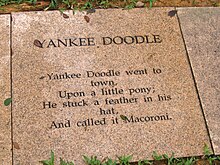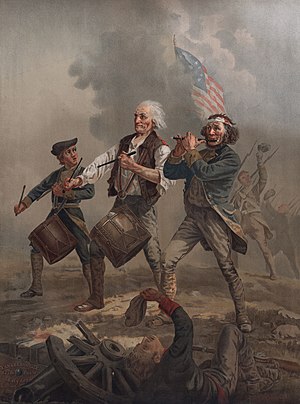Yankee Doodle
| "Yankee Doodle" | |
|---|---|
| Roud #4501 | |

The first verse and refrain of Yankee Doodle, engraved on the footpath in a park.
|
|
| Song | |
| Published | 1780s |
| Composer(s) | Traditional |
| Language | English |
 |
|
| Artist | Archibald MacNeal Willard |
|---|---|
| Year | circa 1875 |
| Type | oil |
| Dimensions | 61 cm × 45 cm (24 in × 18 in) |
| Location | United States Department of State |
"Yankee Doodle" is a well-known Anglo-American song, the early versions of which date back to the Seven Years' War and the American Revolution (1775–83). It is often sung patriotically in the United States today and is the state anthem of Connecticut. Its Roud Folk Song Index number is 4501.
The melody is thought to be much older than both the lyrics and the subject, going back to folk songs of numerous peoples of Medieval Europe.
The tune of Yankee Doodle is thought to be much older than the words, and many peoples knew the melody, including those of England, France, Holland (modern Netherlands), Hungary, and Spain. The earliest words of "Yankee Doodle" came from a Middle Dutch harvest song (which is thought to have followed the same tune), possibly dating back as far as 15th century Holland. It contained mostly nonsensical and out-of-place words, both in English and Dutch: "Yanker, didel, doodle down, Diddle, dudel, lanther, Yanke viver, voover vown, Botermilk und tanther." Farm laborers in Holland at the time received as their wages "as much buttermilk (Botermilk) as they could drink, and a tenth (tanther) of the grain".
The term Doodle first appeared in English in the early seventeenth century and is thought to be derived from the Low German (a language close to Dutch) dudel, meaning "playing music badly" or Dödel, meaning "fool" or "simpleton". The Macaroni wig was an extreme fashion in the 1770s and became contemporary slang for foppishness.Dandies were men who placed particular importance upon physical appearance, refined language, and leisure hobbies. A self-made "Dandy" was a British middle-class man from the late 18th to early 19th century who impersonated an aristocratic lifestyle. They notably wore silk strip cloth, stuck feathers in their hats, and bore two fob watch accessories simultaneously (two pocket watches with chains)—"one to tell what time it was and the other to tell what time it was not". This era was the height of "dandyism" in London, when men wore striped silks upon their return from the Grand Tour, along with a feather in the hat.
...
Wikipedia
